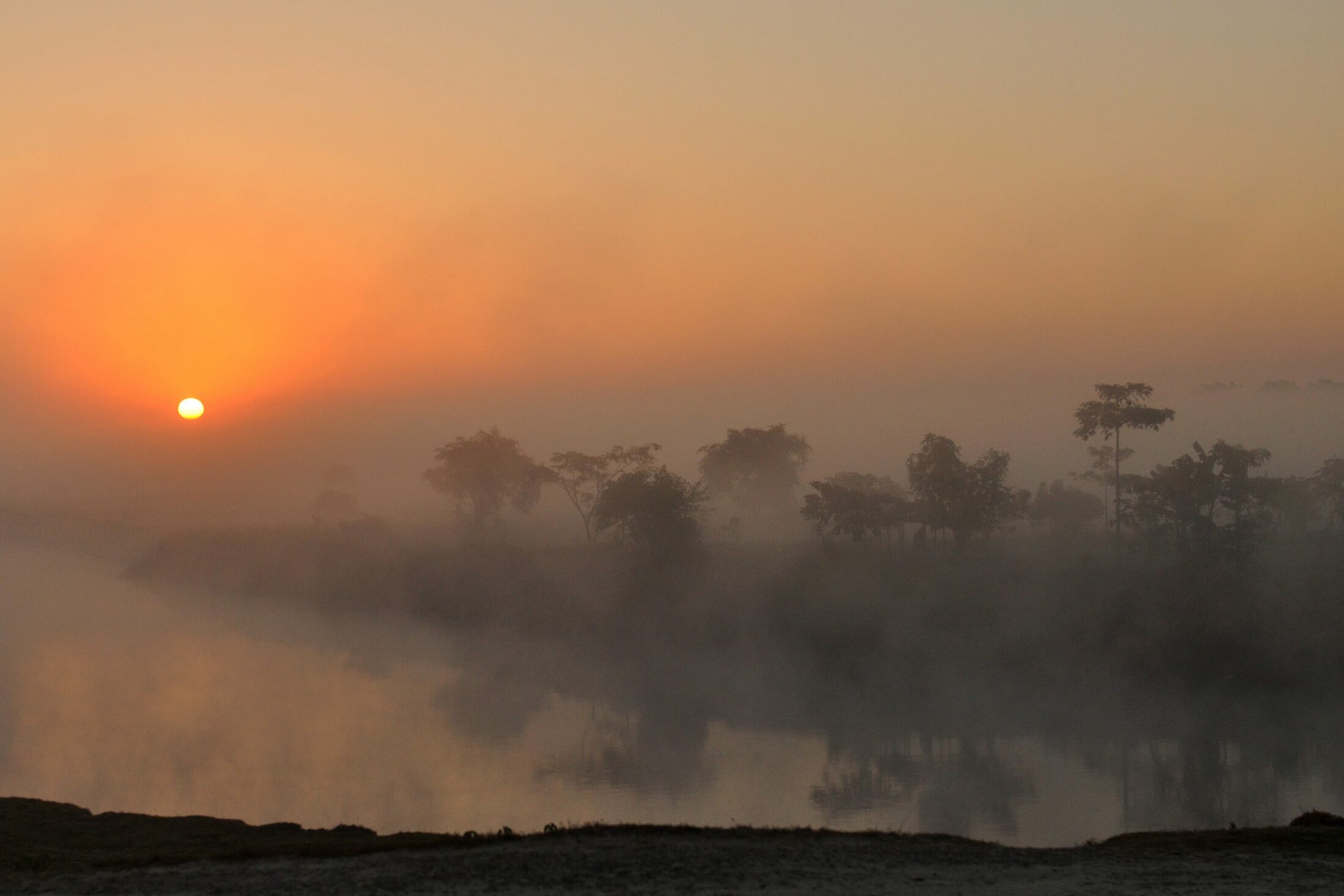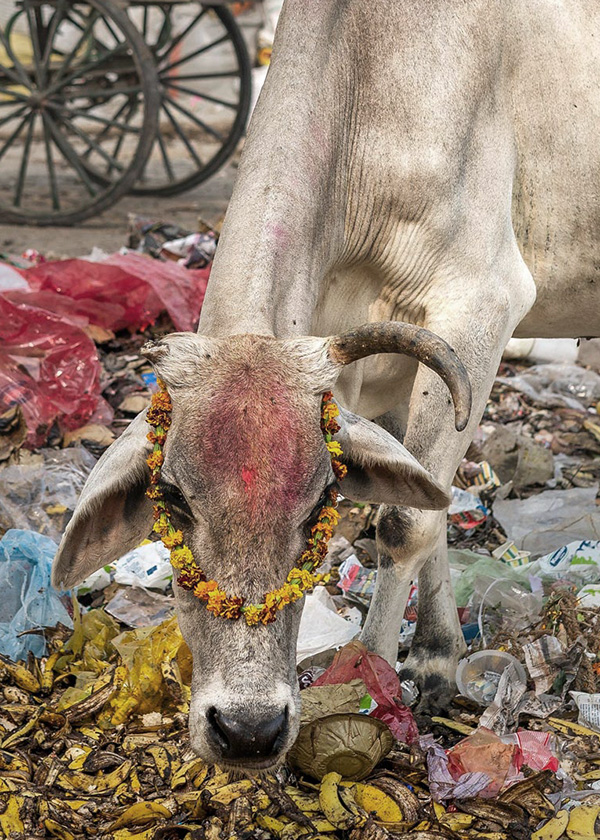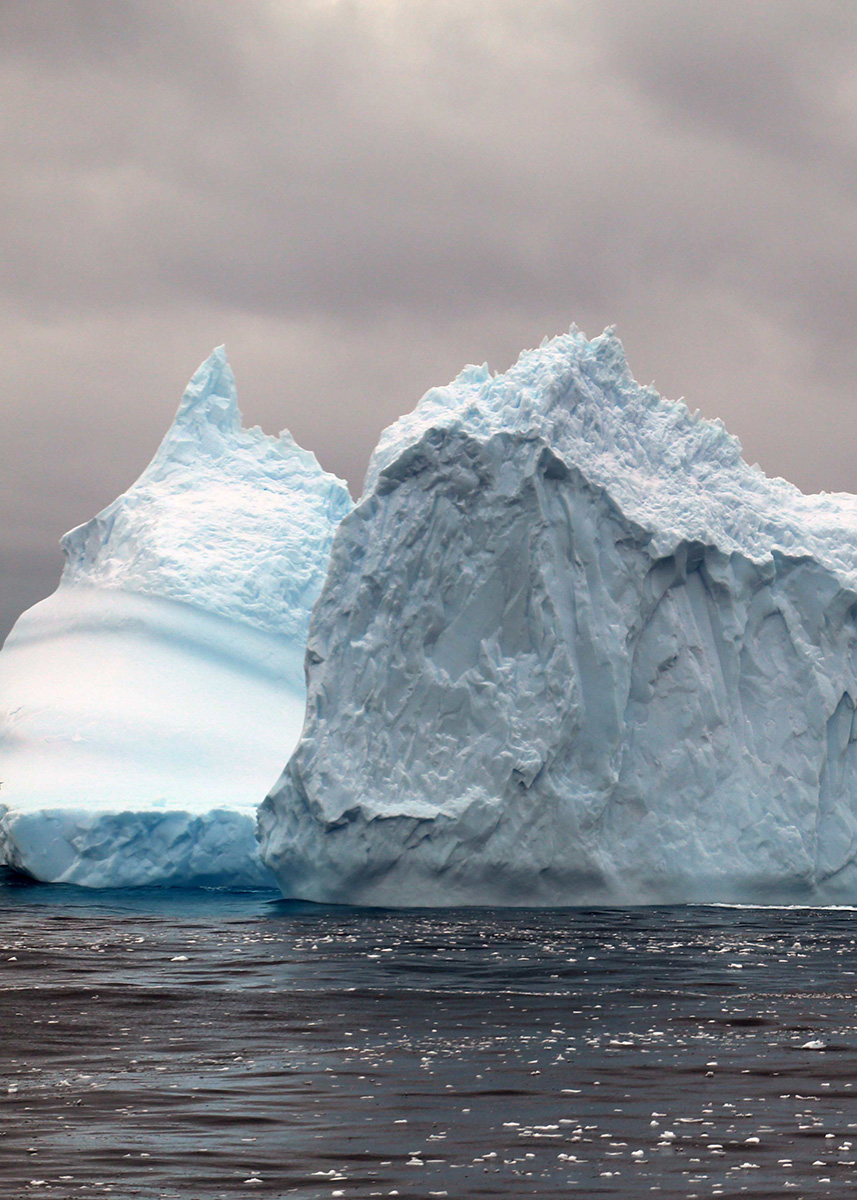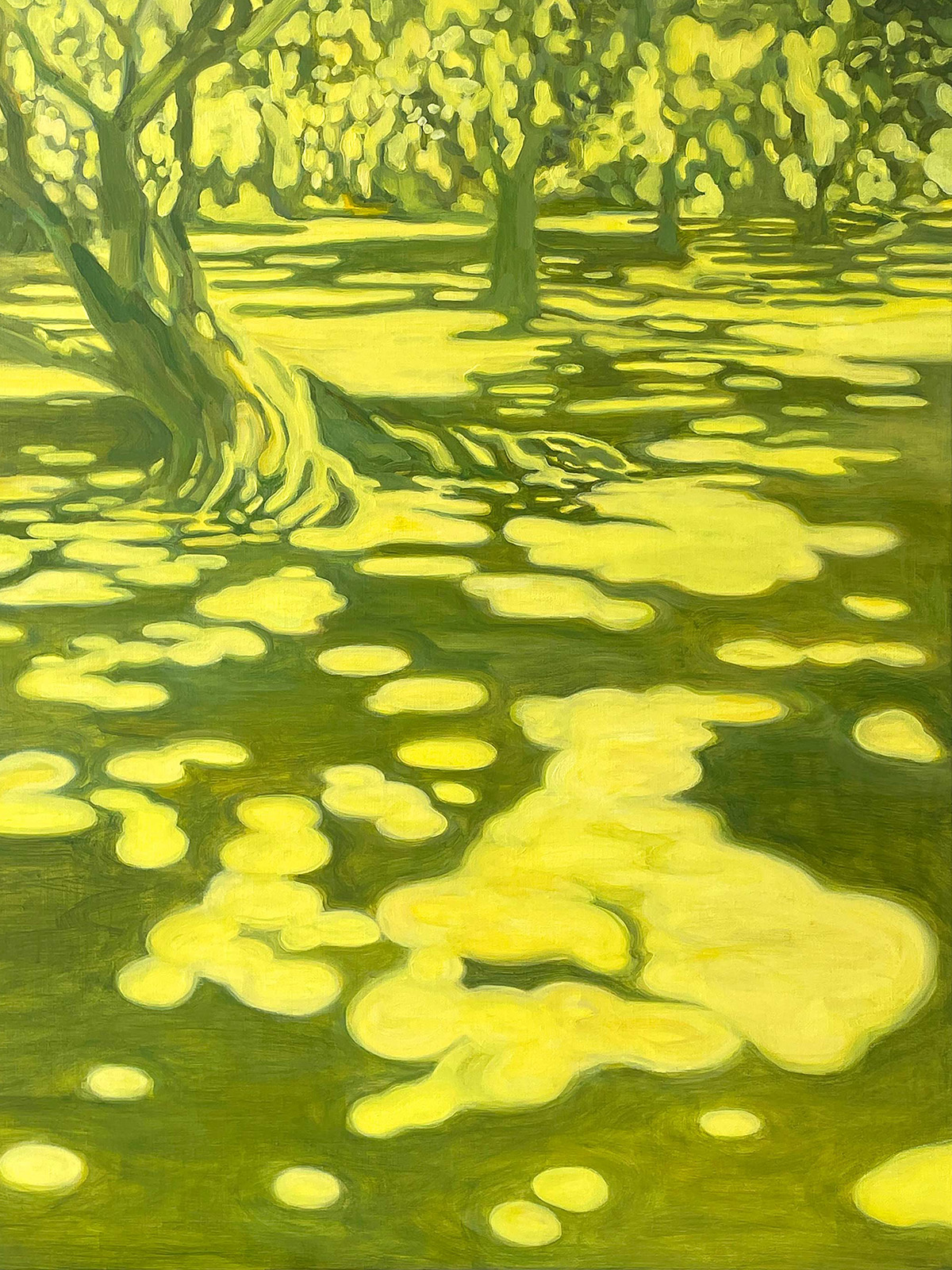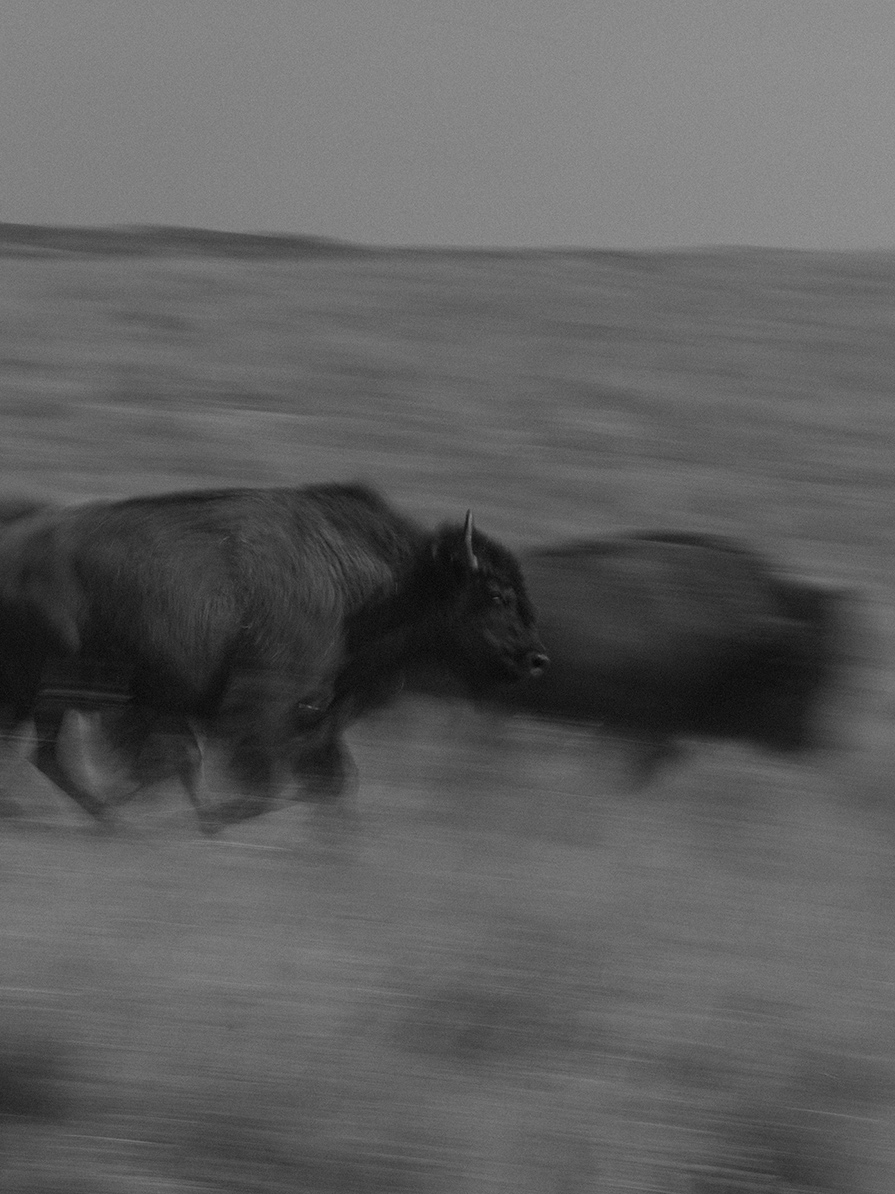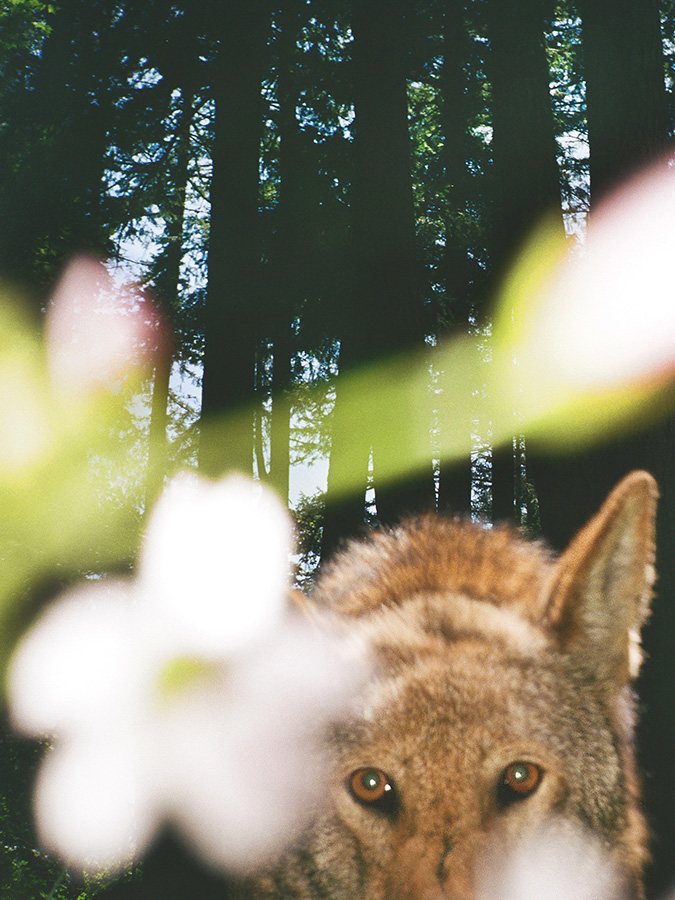
Arati Kumar-Rao is a National Geographic Explorer and an independent environmental photographer, writer, and artist who documents ecological degradation. She chronicles South Asia’s changing landscapes and climate and their effect on livelihoods and biodiversity. Her work has appeared in National Geographic, The Hindu, #Dysturb, The Guardian, BBC Outside Source, Hindustan Times, and Mint.
Arati Kumar-Rao ventures into a forested river gorge in the hidden land of Pemakö, which exists deep within the heart of the Tibetan Buddhist belief system. Long considered impenetrable, the grind of industry now threatens this prophesied “promised land.”
In the Tibetan Plateau near the northwestern tip of Nepal—in proximity to the sacred Mount Kailash, revered as the abode of the Hindu god Shiva—hangs a tongue of the Angsi glacier.
From the tongue of that glacier flows a trickle of water that bears the name Tamchok Khambab, a name given in the Tibetan holy book Kangri Karchok that loosely translates to “the river with a mouth like a horse’s ear.” This river is unlike any other on Earth.
Cerulean at times, emerald at others, embracing into its fold several other trickles, collecting sediment and gravel along its course, swelling and growing, this river takes on many names, and as many personalities, as it wends its long way home from the high plateau of Tibet to the Bay of Bengal, which borders peninsular India.
By the time it reaches the southern side of the Tibetan capital, Lhasa, the trickle that was the Tamchok Khambab swells to become Yarlung Tsangpo, “The Great River.” It pushes east for almost 1,625 kilometers, then makes a hairpin bend and vanishes into a deep gorge that straddles the border between China’s Tibetan Autonomous Region (TAR) and India. It then reappears on the Indian side as the Siang river.
British botanist Frank Kingdon-Ward, who traveled in this region in 1926, was astounded by what he saw. In his book The Riddle of Tsangpo Gorge, he says, “Everywhere, by cliff and rock and scree, by torn scar and ragged rent, wherever vegetation could get and keep a grip, trees grew; and so, from the grinding boulders in the river-bed to the grating glaciers above, the gorge was filled with forest to the very brim.”
The thickly forested gorge that stretches from Kongpo in TAR to Arunachal Pradesh in India is Pemakö—the most famous of the Tibetan Buddhist hidden lands, or beyul. Guru Padmasambhava (Guru Rinpoche), who is credited with introducing Tantric Buddhism to Tibet in the eighth century, concealed these locations in his lifetime and decreed that they could only be revealed to Tibetan Buddhists fleeing from political strife and seeking sanctuary. He further decreed that only one who was worthy could “reveal” such a hidden land and make it accessible to those in need.

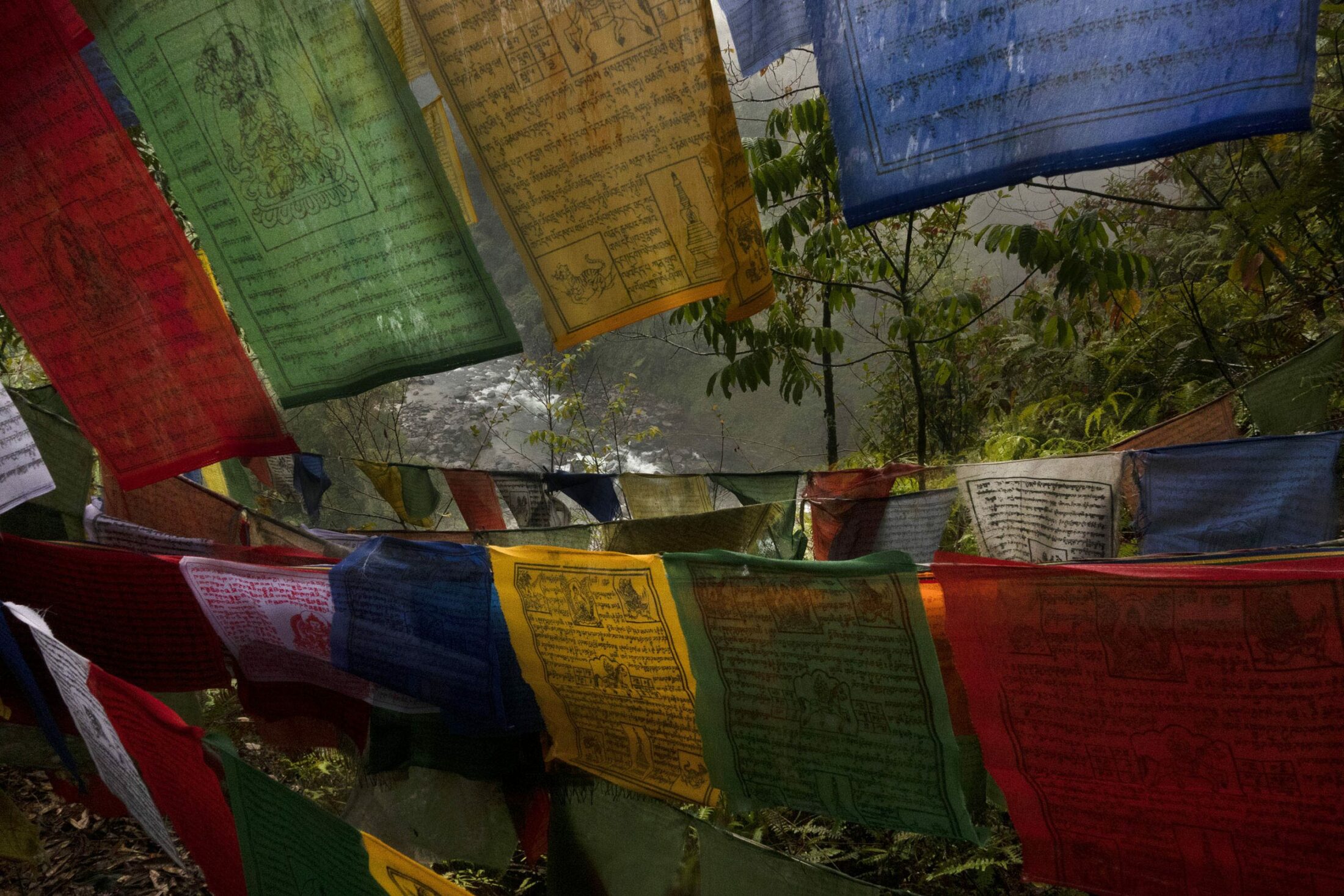
In the 1800s, The Great Game played out on the chessboard of Central Asia and Tibet for control of this strategic region. The Russian tsar moved in from the north; the British Raj countered from the south. Threatened from both sides, the Qing emperor in China sealed the 2,400-km border of Tibet in 1850. In 1910, the Qing official Zhao Erfeng, whose ruthlessness earned him the sobriquet “Zhao the Butcher,” invaded eastern and central Tibet and unleashed hellish violence on the Khampas, residents of the Kham region.
This was precisely what Guru Rinpoche had provided for. And in accordance with his decree, one who was “worthy” arrived in the form of Dudjom Drakgnak Lingpa, a tertön (revealer of treasures), who opened up for the oppressed people of the Kham region the previously hidden land of Pemakö. “The upper end of the valley,” Lingpa wrote in his guide, “is steep and narrow, while its lower end is wide. The mountain peaks and valleys together form the petals of an open lotus, and the sound of the river’s rushing waters can be heard constantly.”
Here, rainbows shone continuously through thick forests full of medicinal plants, and crops grew in abundance. Most importantly, this beyul was indestructible. “No hostile forces,” writes Lingpa, “can destroy this fortress-like valley. It is the incomparable Enjoyment Body, Sambhogakāya, the outer, inner, secret and most secret supreme realm.”
It was in this fabled region, straddling India’s border with China’s TAR, that the fleeing Khampas, known in India as Khambas, settled and, in time, grew into what is now among the largest ethnic groups in the lower Pemakö region.
This sacred landscape is considered to be the geographical manifestation of the sow-headed Tibetan Goddess of Wisdom, Queen of the Dakinis—the embodiment of Wisdom and Energy in female form, who also goes by the names Vajravarahi or Dorje Phagmo. Her five chakras—head, throat, heart, navel, and secret—lie on the border of India and Tibet, along the Tsangpo-Siang river basin.
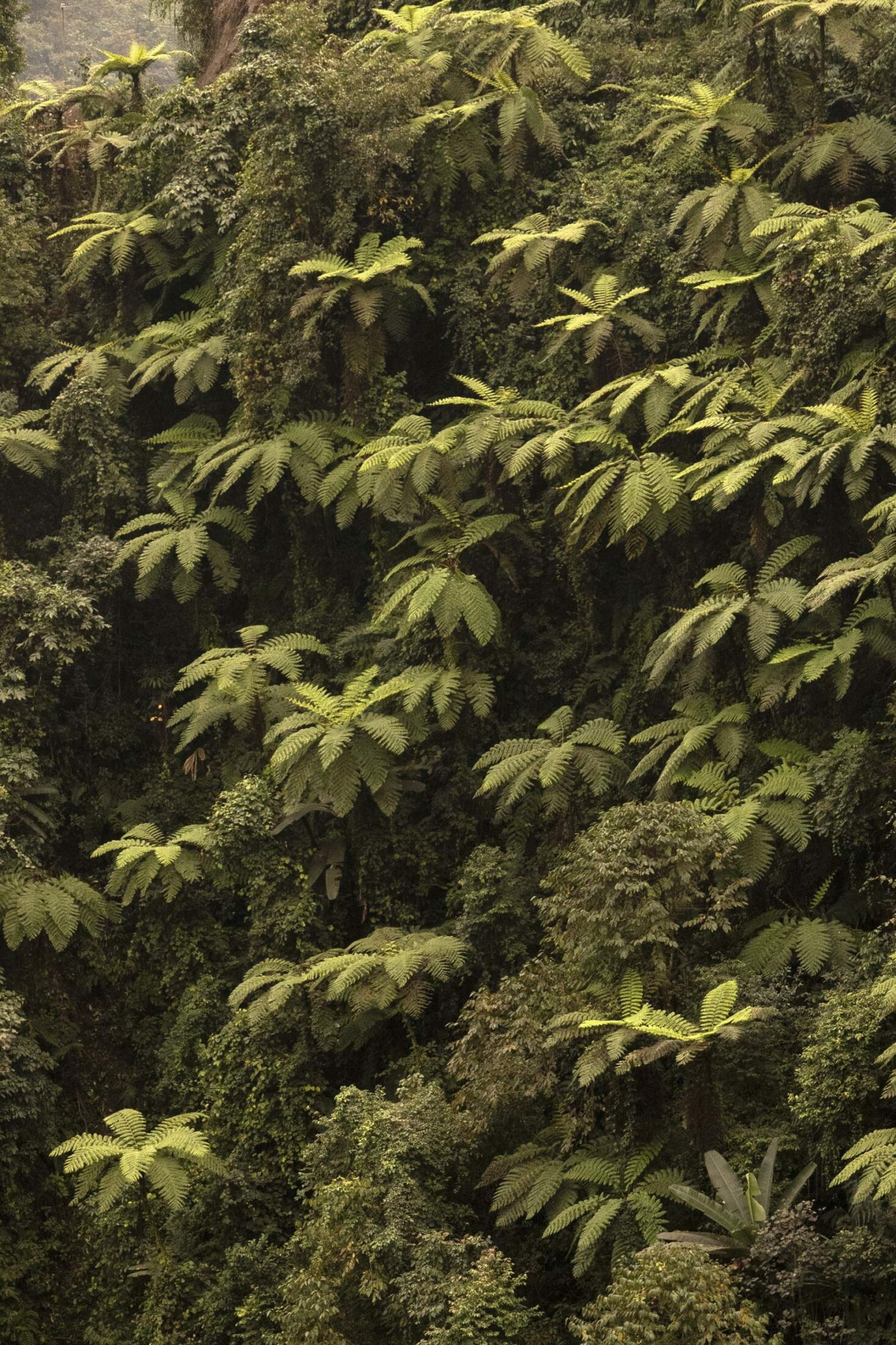

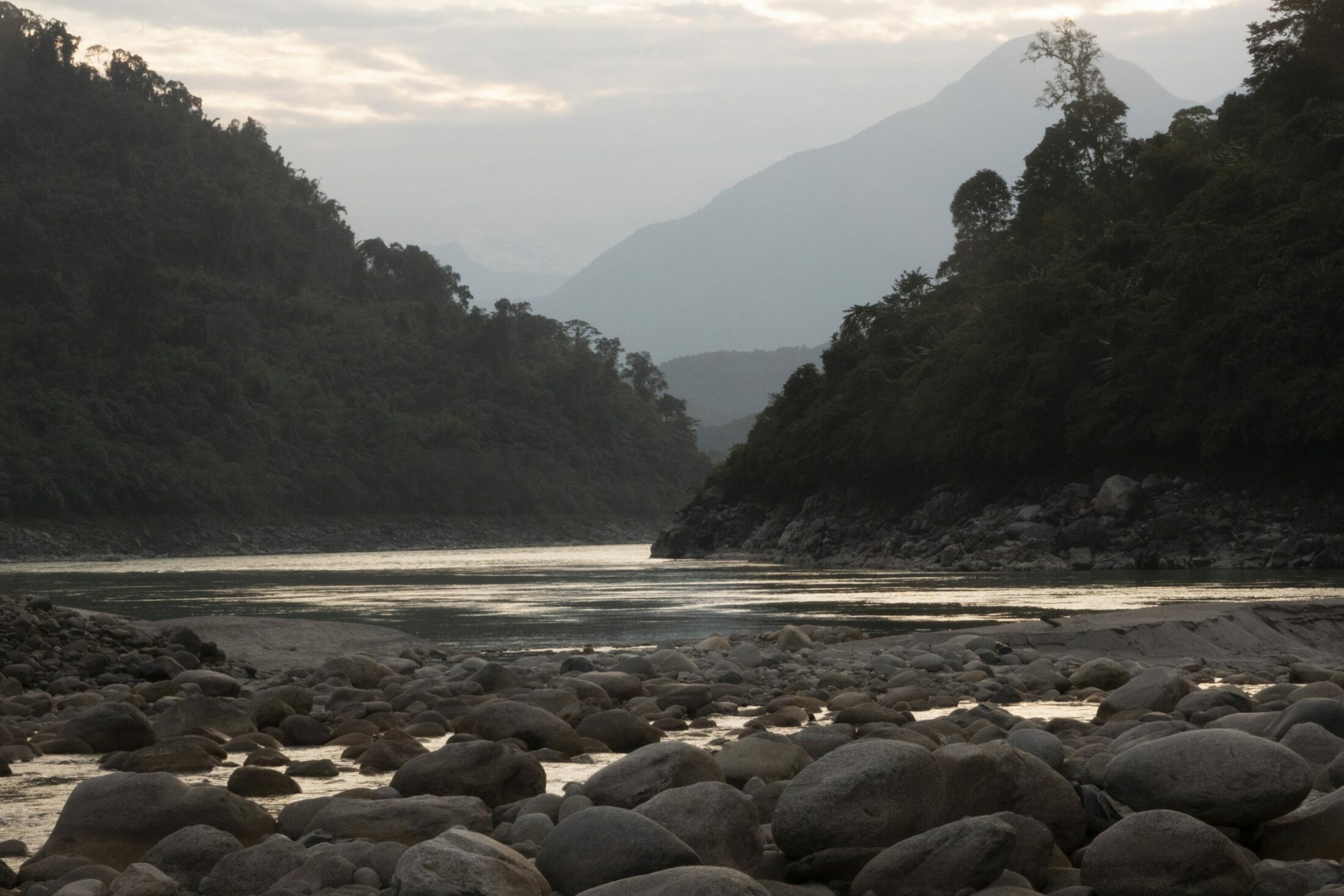
The lofty peak of Kangri Karpo in TAR manifests as the Goddess’s head; the peaks of Namche Barwa and Gyala Pelri, both on the Chinese side of the border, are her breasts. The lower chakras lie on the Indian side of the border. Here, nestling within the holy mountain of Devakota, is the sacred womb of the Goddess. A tributary of the Siang, known as the Yang Sang Chu or “Secret River,” runs alongside; its waters are said to possess the five wisdoms. And finally, her secret chakra is at the confluence of the tributary Yang Sang Chu and the main stem of the Siang, on the Indian side.
It is the cusp of spring when I reach the lower plains of Assam. With my friend and guide Katon for company, I wind my way up the Siang valley and climb upwards, east, into the beyul of lower Pemakö, deep in the valley of the “secret river.” I first heard about this little river eight years ago; since then, it has exercised an inexplicable pull on my imagination. I pored over maps to trace its course from the point of origin to where it joins the Siang, and I read all available literature about it. The part that fascinated me the most was an area that bent around a mountain, almost circumambulating it. This mountain—the sacred Devakota—is believed to be the seat of Guru Rinpoche, and the womb of the Goddess.
On previous trips up the Siang valley, I only made it as far as the confluence of the Yang Sang Chu, the “Secret River,” and the Siang. True to its name, the Yang Sang Chu flows so far below, deep in the bowels of the forested gorge, that there are few places where you can actually see anything more than a rush of rapids before it disappears under an overhang or around a bend. This time, I intend to push deeper into the river valley.
Katon and I make our way up through the Siang valley towards the Chinese border. As the road bends around a mountain, a black eagle soars into view at eye level. Her six-foot wingspan traces wide clockwise spirals; she then banks anti-clockwise, her primary feathers outstretched like fingers. Her head, tucked tight between her wings, is angled down as she intently scans the fog-shrouded floor of the valley, nestling at the foot of steeply sloping montane forests of false hemp trees, East Indian almond, white-boled Canariums flushed red, silk-cotton trees exploding red with inflorescence, magnolias, and dipterocarps.
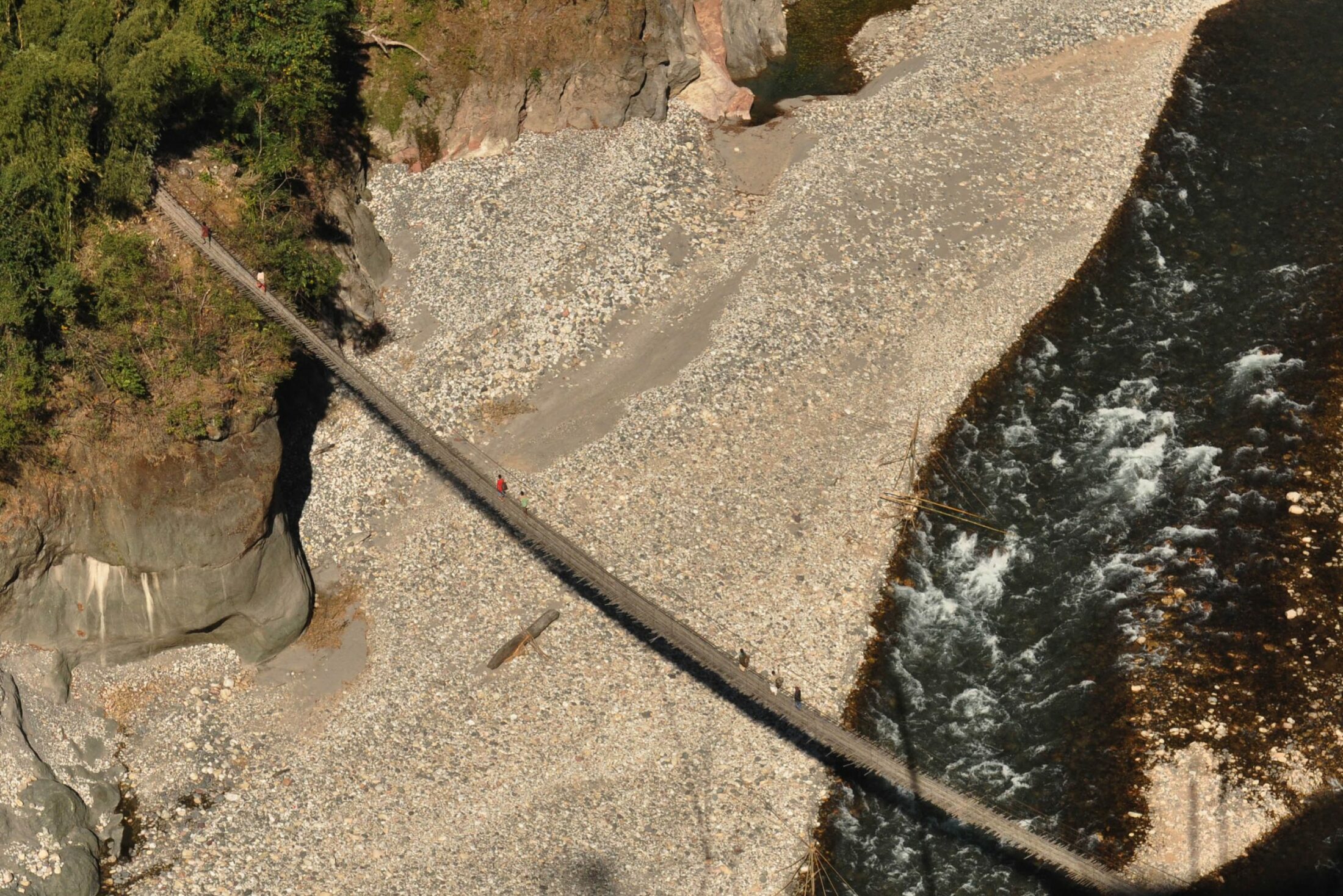
Poking out at regular intervals between these semi-evergreen trees are ancient tree ferns that predate dinosaurs, having evolved 320 million years ago. The velvet worm, the first creature believed to have colonized land, was found to live under these tree ferns, but no scientist has looked for it in over a century. These ancient ferns, thickly knitted in shades of green, are occasionally interrupted by small patches of cultivated clearings that gleam golden, each one studded in its center with a little palm leaf–roofed hut on stilts. All of it disappears into the foggy gorge, some 500 to 700 meters deep.
Katon shuts off the engine and we sit in the parked car, watching the raptor as she catches a thermal and rises upwards. The late-winter sun glints off her back; for a brief moment she glows golden, then disappears behind a massive ficus tree. The sun burns the fog away in lifting wisps to reveal the Siang, here colored teal, sloshing past boulders and around river rocks on its way down to the plains. I thrill to a sight I never tire of seeing.
“Siang is a contraction of Adi words,” says Katon. Asi in Adi means “water” and àpì-ang means “heart.” Si-ang, in the language of the Adi people who inhabit this valley, means “the river that flows through our heart.”
He leans forward, peering up at an overhang of rock capping a steep cliff rise above us. “Here is where the Adis stopped the British,” he says, voice edged with pride. “They built these rock chutes: large baskets of rocks held up by cane ropes tied to trees.” He cups his hand to demonstrate. When the marching column of British sepoys and officers advanced to just below the overhang, an Adi positioned on the opposite hill gave the signal; an Adi elder waiting on the overhang snapped the rope and rocks cascaded out of the basket and down onto the marching column to devastating effect. “It was my granduncle who cut the rope once,” Katon says. “It stopped the Britishers; survivors shot him as he fled. He died—but he had snuffed out that invasion.”
Katon straddles two very different worlds. He is half Adi, a fierce and valiant animist tribe of the Siang valley, famed for having beaten back three British “abor expeditions.” “Abor” is Assamese for “savage”; the Adi clans living in the villages dotting the Siang basin earned that moniker for the ruthlessness with which they killed intruding foreigners perceived as hostile. The colonial occupiers of India, even with their advanced weaponry and warcraft, found this region impregnable in the late nineteenth and early twentieth centuries.
Katon is also part Khamba, the Tibetan Buddhist warrior clan that migrated south from Tibet in the early 1900s, fleeing persecution.
We halt for the night on the outskirts of the town of Damro, in the Yamne river valley. The Yamne is another of Siang’s tributaries, flowing through richly biodiverse terrain that plays host to various Adi clans. Old-growth, impregnable forests crowd the stacked mountain ranges. Panikheti terraces, which divert small mountain streams into fields for growing rice, spread out near the valley floor. Contrasting with this is the rain-fed jhum kheti. This type of cultivation, on vertiginous seventy- to eighty-degree inclines, moves every few years as soil becomes less fertile, and shifts back as the fallow soil regains fecundity.
Life here seems untouched by the passage of centuries; I feel as if I have dropped down a rabbit hole into an earlier, elemental age. Adi hunters effortlessly scale 4,000-meter peaks, up beyond the tree line, to hunt for meat and also to harvest the aconite plant, which provides a deadly poison for their arrows. Children tumble down grass and mud slopes on sleds made out of bamboo, with little round wooden wheels. Women pound the pith of a sago palm in a large, inverted wooden cone mortar for flour. Men mend their bamboo traps to hunt squirrels and birds in the forest. Families collect medicinal plants to make the starter cake for the ubiquitous local rice brew, apong. They forage for mushrooms in the forests above the villages and join in hunts for the free-roaming Bos frontalis, a large, semi-domesticated, bison-like cattle that the locals call “mithun.”
Si-ang, in the language of the Adi people who inhabit this valley, means “the river that flows through our heart.”

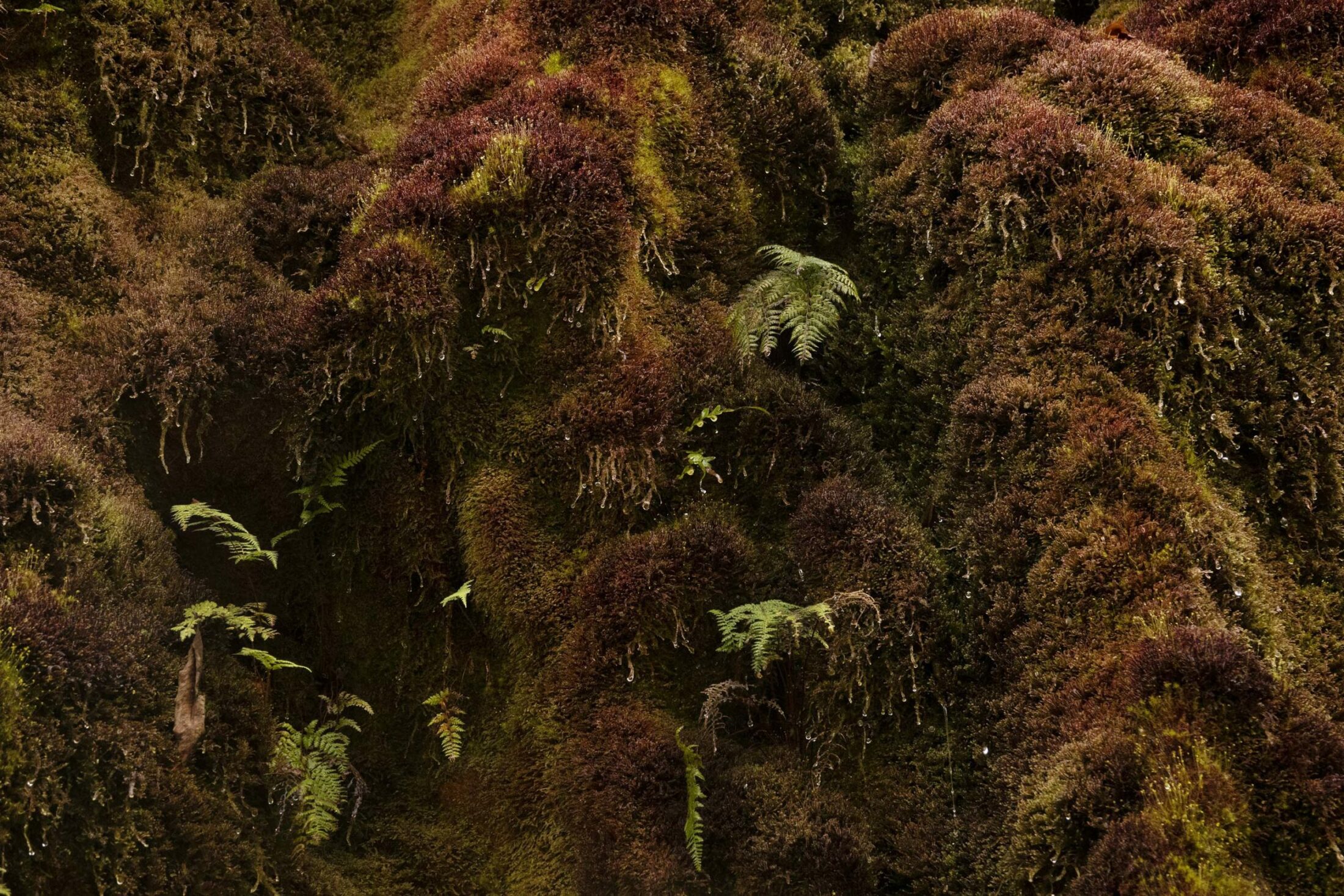
A day later, Katon and I make the trip up to lower Pemakö, and the confluence of the Siang and Yang Sang Chu. It takes us half a day by car. “Road” is a misnomer for the route we take. Mountainsides are being clawed and chewed up to create wider roads, and the resultant landslips are an obstacle course we must navigate. His brothers have informed Katon that the road construction has begun to gnaw into lower Pemakö itself. Age-old hanging bamboo bridges, the traditional walking paths of travelers, hunters, and pilgrims, have fallen into disrepair. Our original idea of walking for three days in the lower Pemakö region are shelved; we end up with sore backsides from half a day of bumping along on a rocky “road.”
As we near lower Pemakö, it is not merely the landscape that changes, but life itself. Here, no one recognizes the Adi name “Katon”—my friend introduces himself as Pema, a Khamba name he uses when he visits the region that hosts half his identity. Here, everyone speaks either of two Tibetan dialects, Memba or Khamba; Katon speaks fluent Khamba when he visits. Save for a few far-flung hamlets and gompas, lower Pemakö is all jungle and high peaks of snow. There is no electricity in the valley, no phone network.
Swarms of bloodsucking black flies called damdims get to work; their bite makes the blood spill from open wounds. I try in vain to flick them off, while keeping a wary eye out for leeches. There are gongs and prayer beads and prayer wheels and lamas and chanting and drums everywhere—and above it all, the pervasive sound of the gushing waters of the “secret river,” the Yang Sang Chu, flowing below in the gorge.
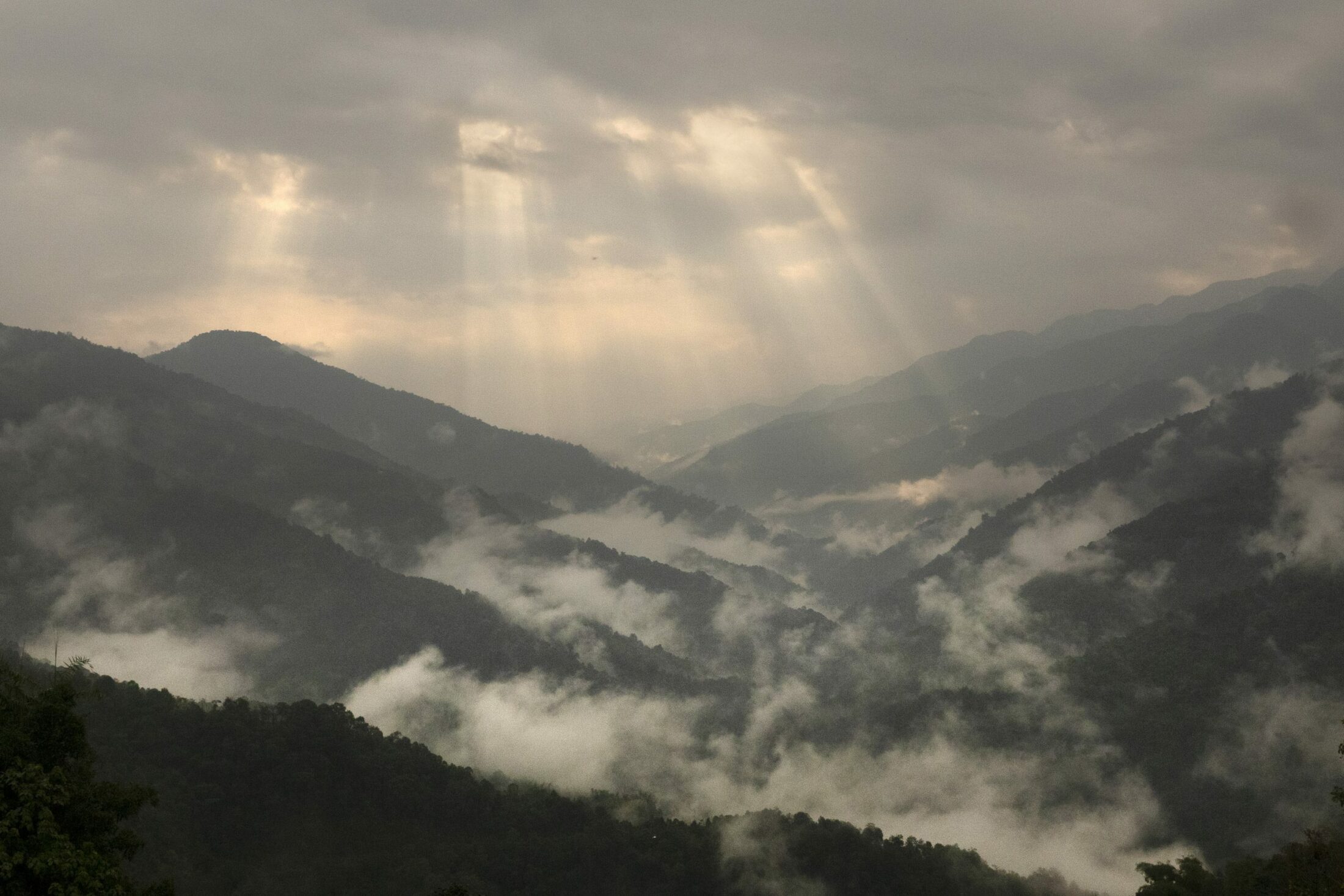
It has rained all night, and in the indigo of predawn, the lotus valley and the womb of the Goddess are shrouded from view. Mist rises and falls and rises again. It is as if the sun has forgotten to rise. The clouds bulge and burst, and thick drops pelt the ground. Katon—now Pema—makes a snap decision. “Let’s go anyway,” he says. The idea is to climb down about 600 meters from our perch at 1,375 meters to the valley floor and then up the holy mountain of Devakota for the kora, a clockwise circumambulation that pilgrims make around holy places and structures.
Devakota, for the Buddhists, is the “Deathless Extreme Secret Place” of Guru Rinpoche’s prophecy and promise—the womb where the “seeds of humanity will regenerate themselves after being extinguished at the end of a Dark Age.” When famines and epidemics and wars and violence prevail at the hands of the “enemies of Dharma,” it is said, this wellspring of life which resides at the top of Devakota, under the throne of Guru Rinpoche, will regenerate and renew the world.
We shoulder our backpacks and set off. The bloodsucking black flies are everywhere; their anti-coagulating bite has my blood flowing freely from my hands and other exposed parts of my body. Pema laughs at my plight—the black flies don’t bother him, he says; he’s grown up with them. He tells me of times when he climbed to the three high sacred spaces in lower Pemakö, among the now-hidden snow mountains, where the rock faces are so sheer they “are in your nose”; where leeches attack your eyes; where wild boars charge from the undergrowth of banana groves, Asiatic black bears scalp heads, tigers walk on pilgrim paths, and vipers litter the humus. The hidden lands are hard to negotiate by design, he says; the ancient prophecy decrees that only the pure of intent and the truly devoted will make it there and endure. And yet, the Khambas, Membas, and other Tibetan Buddhist sects keep coming to Pemakö, drawn by Dharma and the Promised Land.
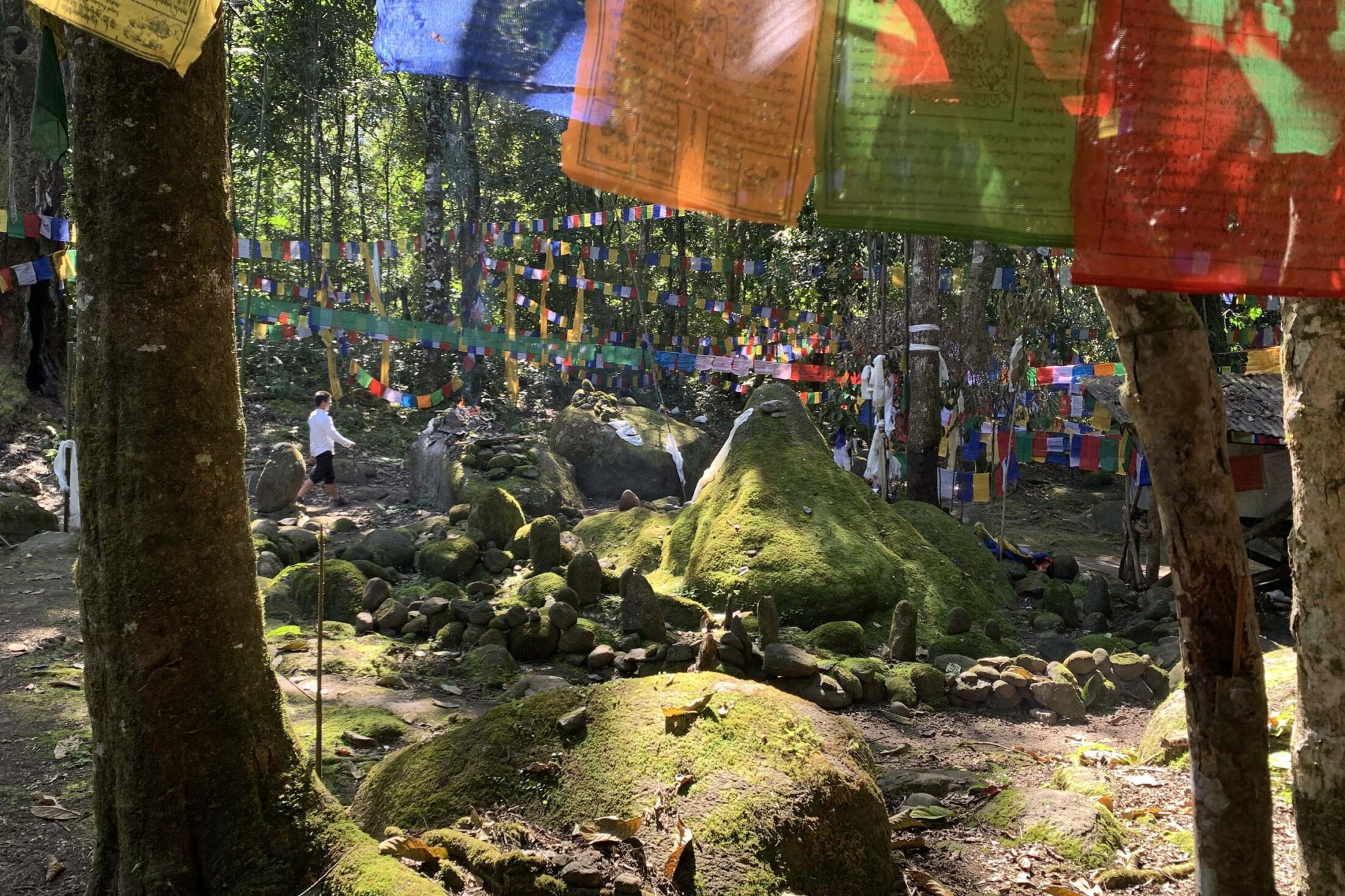
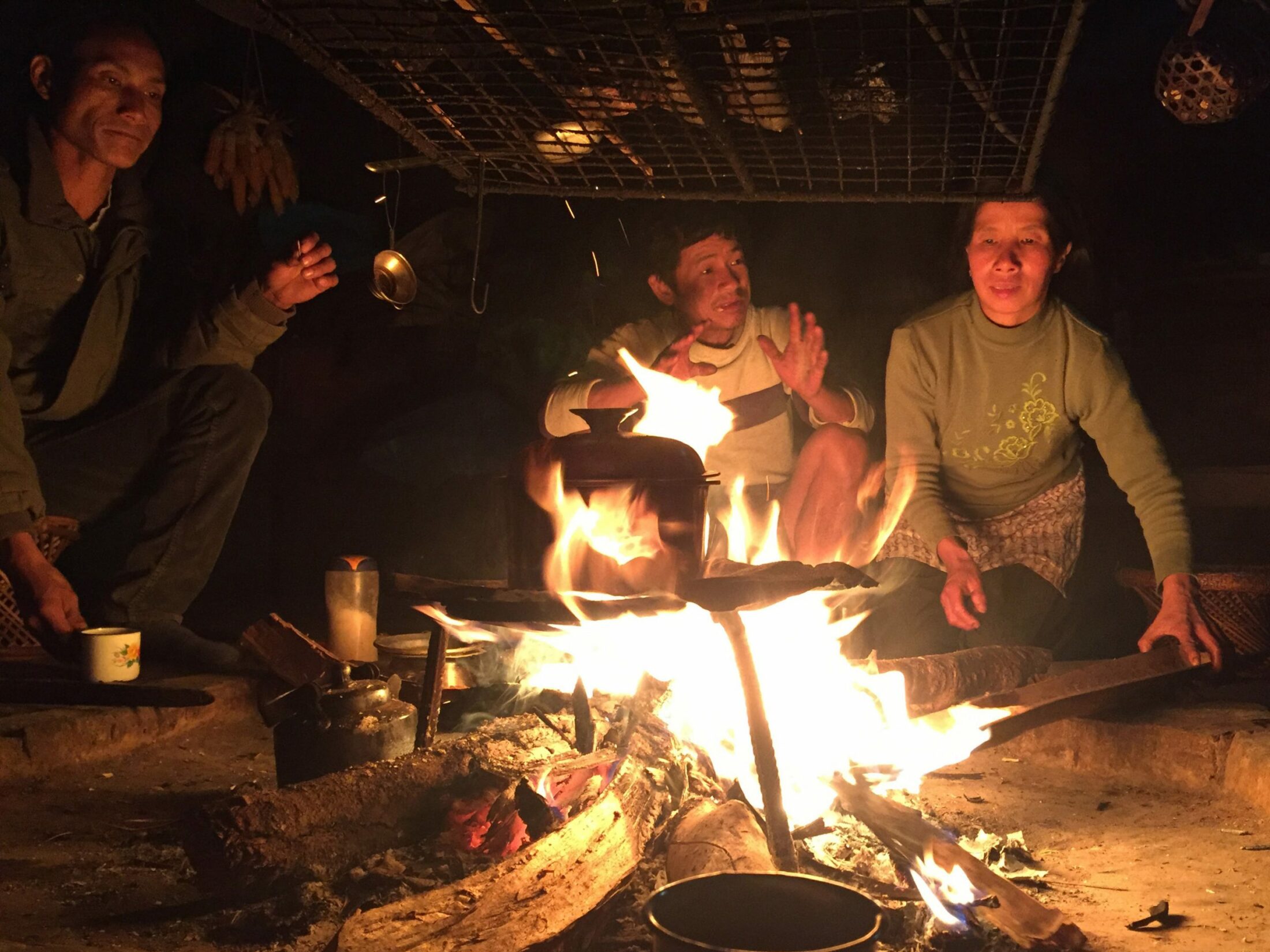
As I trudge up the slope of the Devakota, my feet constantly slip and slide, the conditions underfoot made treacherous by rain. Each slip, each slide, has my heart hammering—the path nudges along narrow ledges that drop precipitously into the Yang Sang Chu gorge. My clothes are sodden, my skin is soaked, and the rain pelts down.
We are deep within the heart of the Buddhist belief system. A single kora, a circumambulation, around Devakota will bring you ten billion siddhis—unusual skills and powers, unimaginable yogic advancement. To drink the holy water seeping through the mountain is to extend your life by twenty years. To meditate one day on the holy mountain is equal to meditating for one year anywhere else on Earth. This mountain, it is believed, is where the three holiest peaks—Tsetapuri to the north, Riwo Tala to the south, and Pema Shelri to the east—concentrate their sacred energies. For Tibetan Buddhists, the blessings of Guru Rinpoche are worth the grueling trek with its multitudinous dangers.
To lean over the side of the hanging bridge across the Yang Sang Chu and peer through the prayer flags toward the forests beyond is to allow hundreds of years of faith and history and old-growth Nature wash over you. The little “secret river,” ever in a hurry, rushes around Devakota en route to its meeting with the Siang. Mist, like the very breath of the gods, rises from thickly knitted canopies. Rocks are swaddled in moss mats an inch thick and dripping with moisture. I cup my hands beneath one and drink the water that drips into my palms. It is sweet, and cold, and life-giving.
Loopy, twisted woody vines, lianas, shrouded in lichen and ferns and fungi and orchids festoon the understory of the forest. Deep, hollow burrows tell of a time when bears hibernated. Prayer flags of devotees who have trekked here over the years hang on every bamboo handrail and twisted cane wire, some so old they are now lichen-and-fungus flags. The warm aroma of humus and lignin combine with incense, lit at a chorten. Caves here are believed to be the home of spirits and goddesses. Peering down from a high ledge, I see a rivulet rushing out of a cave and flowing down to join the Yang Sang Chu. Such caves are believed to exude sindura, the sacred menstrual flow of the Goddess of Wisdom.
Faith and fable, devotion and a sense of destiny, hang suspended in the air around us; the power of this place, infused with centuries of belief, is strong enough to cradle, and revive, the weariest of pilgrims who seek to circumambulate the womb of the Goddess.

At the top of the mountain, the Devakota, nestles a tiny monastery. I walk into the single chamber within and instinctively prostrate before the large golden statue of a seated Guru Rinpoche. As prescribed, I raise my hands, palms touching, above my head. I rise to my knees, palms together in front of my chest, and I ask for blessings for all creatures on Earth. I get up and raise my hands again, and fall to my knees again, this time asking for blessings for my family. I stand up a third time and raise my hands high above my head, then fall to my knees—and suddenly, unaccountably, the tears come.
I weep, my breath coming in sharp, short intakes that echo around the walls of the monastery. A lama seated under the gong stops chanting momentarily to look at me. My knees give way; I sink down to the floor and lean against a carved, painted, ornate pillar. A ginger cat that enthusiastically welcomed us at the top of the mountain crawls into my lap and licks my face. In this place, within the force field of holy mountains that for centuries has attracted the devout from all over the Buddhist world, my worldliness evaporates. In that moment I am stripped of pretense; I feel like I am nothing, and everything, all at the same time.
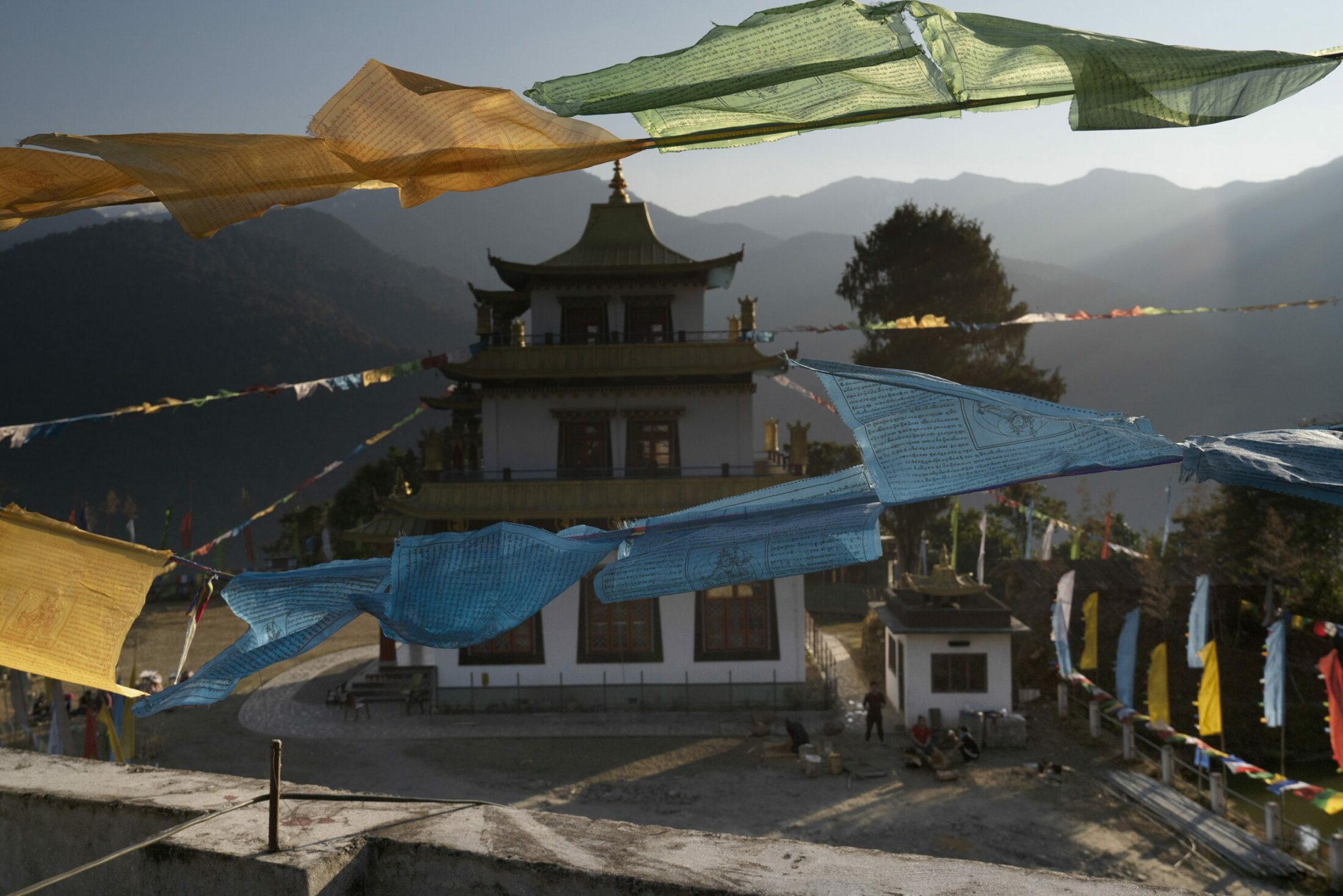
Precious places are by definition fragile, and Pemakö is no exception. If China’s recent five-year plan comes to be, this century will bring new danger to this land. It won’t be long before loud rumblings of heavy machinery and the thunder of blasting reverberate in upper Pemakö, announcing China’s largest hydropower dam, where the Tsangpo falls 6,500 feet to morph into the Siang. This activity, in the name of development, is deadly in a region where the mountains are young and still thrusting upwards: since 1600, most of the largest earthquakes have occurred in the last 120 years. Moreover, any dam built upstream by the Chinese means denial of water and vital sediments to India, midstream, and to Bangladesh, in the lower basin. And all of this is not counting the potential damage to the ecologically fragile hidden lands of the Pemakö, a repository of much Buddhist tradition and culture.
An environmental conflict looms as India, in a bid to stake first claim to the waters of the Tsangpo and to subvert Chinese plans, talks of its intent to build its own dams in the valleys of Arunachal Pradesh. The sites have been identified; when construction begins, vital old-growth forests, towns, hamlets, and whole swathes of Indigenous sacred lands and cultures will be submerged.
The site of the secret chakra of the Goddess of Wisdom, where the Yang Sang Chu meets the Siang, already bristles with tractors and JCBs. India is building a highway across the sacred confluence and down the spine of the Siang valley. Road-cutting machinery chomps the mountainsides on both sides of the border, their incessant whine drowning out the rutting of deer and the call of the whistling thrushes in the forests above. The surge of conflicting emotions induced by my kora and by the perceived sacrilege of ill-conceived infrastructure planning clash in my mind.
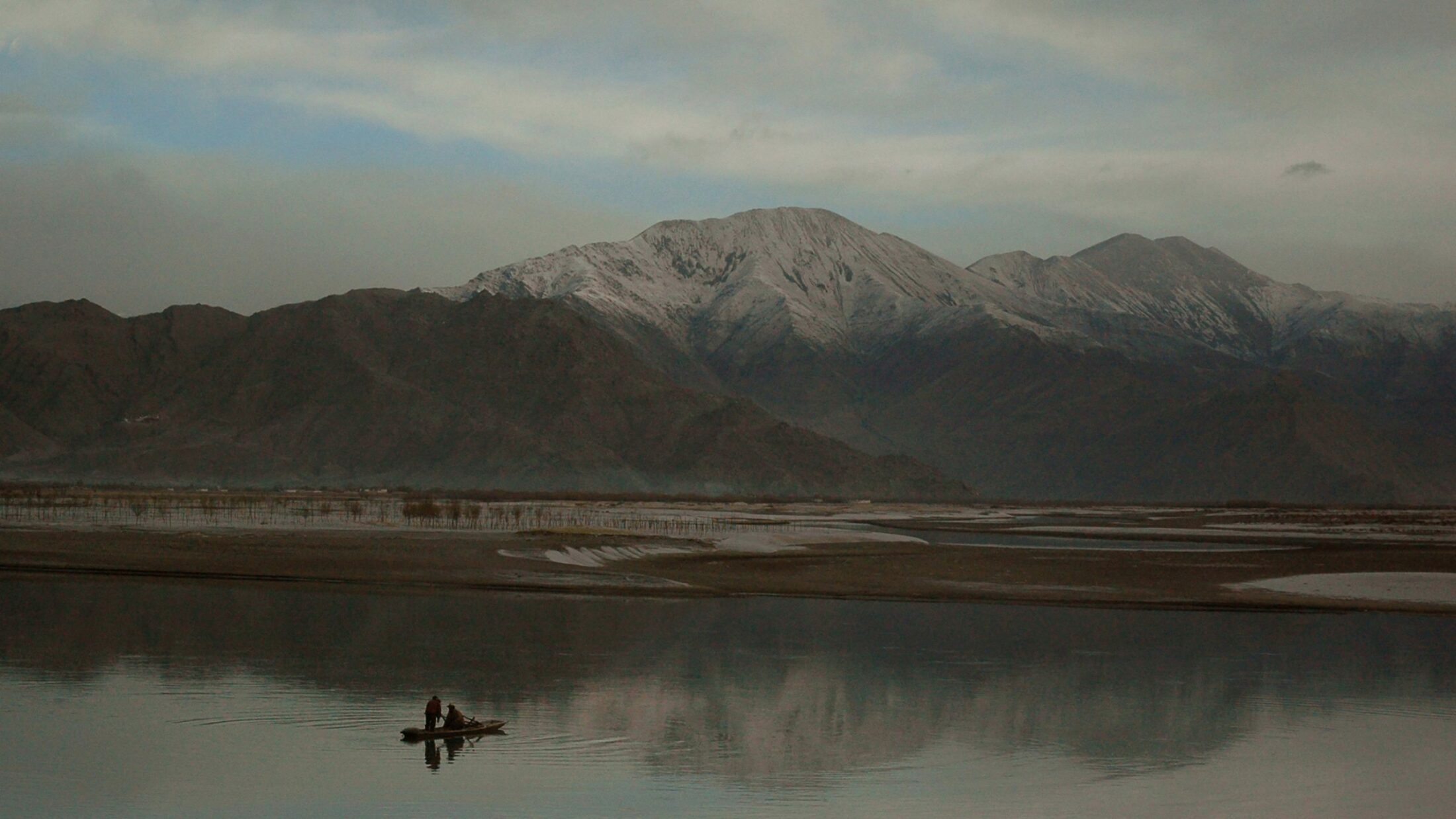
I have watched Katon go seamlessly from an Adi skipping sideways on uneven rocks by the Siang to Pema, the Khamba, moving through the thick stands of old forest, at ease on slippery slopes—both avatars knowing where a bear has paused or which berry is inedible. I have marveled as he swims against a current in a rushing river and lights up wood that drips with rain; I’ve been awestruck by the sight of him hauling forty kilograms up a sixty-degree incline and hacking his way through a stubborn knot of undergrowth.
Katon, in his element, contrasts starkly with young Adi and Khamba students I have met in towns, their heads constantly bent over their phones, their faces lit by the glow of the little screen, their lives and minds and hearts entirely divorced from their ancestral wildlands. A line from Aldo Leopold’s Sand County Almanac comes unbidden to my mind. “Civilization,” Leopold wrote, “has so cluttered this elemental man-earth relationship with gadgets and middlemen that awareness of it is growing dim. We fancy that industry supports us, forgetting what supports industry.”
As we make our way around Devakota, completing the kora, trekking up and down and up again and down again, I trace with my feet the ancient rhythms of this still-beating heart of the Buddhist world. With every step there is a sense of reverence; with every other step there is a sense of impending loss, as I wonder how much longer before this, too, disappears into the maw of “progress.”
